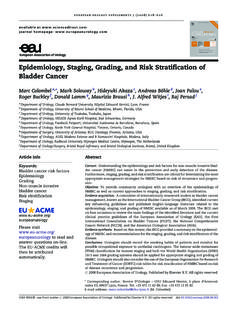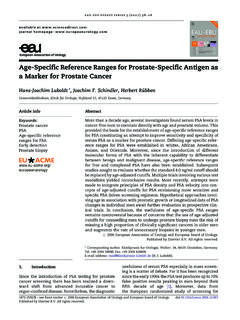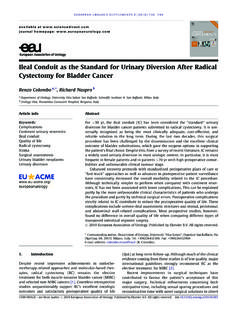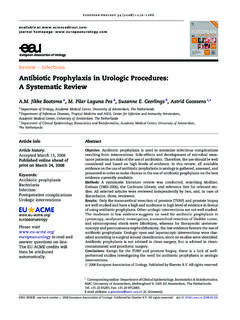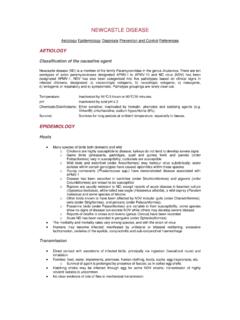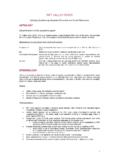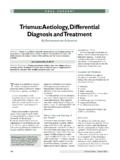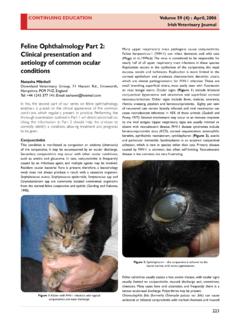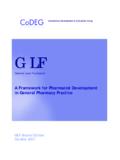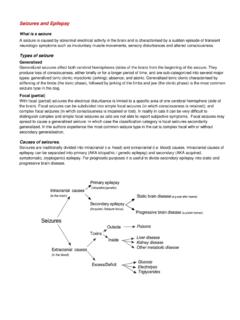Transcription of Epidemiology, Aetiology, and Pathogenesis of …
1 Epidemiology, aetiology , and Pathogenesis of Renal CellCarcinomaChris Protzel, Matthias Maruschke, Oliver W. Hakenberg*Department of Urology, Rostock University, Germany1. IntroductionSignificant advances in molecular medicine have maderenal cell carcinoma (RCC) the prototype solid organmalignancy for targeted medical cancer treatment. Thesenew options have made it possible to prolong the life ofpatients with metastatic disease. However, we are far fromthoroughly understanding the molecular processes of RCCdevelopment, let alone being able to cure advanced renalcancer. RCC is the most common renal neoplasia, and itremains a very aggressive and often fatal are several known histologic subtypes of thisheterogeneous tumour entity with associated distinctmolecular alterations and different clinical outcomes[1 4].
2 Clear cell renal cell carcinoma (ccRCC) is the mostcommon and apparently the most aggressive RCC subtypewith the highest rates of local invasion, metastasis, andmortality. It constitutes 70 80% of all renal cancers [1,5]. Itis estimated that >30% of patients with RCC havemetastatic disease at the time of diagnosis, and 30% ofpatients with organ-confined RCCs develop metastaticdisease after local treatment [6]. Thus RCC remains a verymajor FrequencyRCC overall accounts for 2% of all adult malignancies [7].Worldwide, based on probably incomplete figures, about270 000 new cases are diagnosed per year, and about 116 000patients die per year [8]. In the United States alone, 58 000new RCC cases were diagnosed in 2010, and approximately13 000 patients died of RCC in the same year [7,9].
3 Thiscorresponds to 65 000 new RCC cases per year in theEuropean Union with >25 000 RCC deaths every year [10].E U R O P E A N U R O L O G Y S U P P L E M E N T S 1 1 ( 2 0 1 2 ) 5 2 5 9availa ble at homepage: infoKeywords:Renal cancerEtiologyVHL geneHypermethylationFolliculinAbstractSi gnificant advances in molecular medicine have made renal cell carcinoma (RCC)the prototype solid organ malignancy for targeted medical cancer new options have made it possible to prolong the life of patients withmetastatic disease. However, we are far away from thoroughly understanding themolecular processes of RCC development let alone from being able to cureadvanced renal cancer.
4 RCC is the most common renal neoplasia and it remainsa very aggressive and often fatal are several known histologic subtypes of this heterogeneous tumor entitywith associated distinct molecular alterations and different clinical outcomes [1 4]. The clear cell renal cell carcinoma (ccRCC) is the most common and apparentlymost aggressive RCC subtype with the highest rates of local invasion, metastasisand mortality. It constitutes 70 80% of all renal cancers [1,5]. It is estimated thatmore than 30% of patients with RCC have metastatic disease at the time of diagnosisand 30% of organ-confined RCCs will develop metastatic disease after local treat-ment [6]. Thus, RCC remains a very major challenge.
5 # 2012 European Association of Urology. Published by Elsevier All rights reserved.* Corresponding address: ( Hakenberg).1569-9056/$ see front matter # 2012 European Association of Urology. Published by Elsevier All rights reserved. at least 20 40% of patients diagnosed with RCC die ofthe , there are some geographic, racial, and genderdifferences in the incidence of RCC. RCC occurs more thantwice as often in men as in women. In Europe, the highestincidence is seen in the eastern parts of Europe; Portugaland Spain report the lowest incidence (Fig. 1). The reasonsfor this distribution are unclear. The overall incidence ratefor Europe is estimated at per 100 000 for men and 100 000 for women [10].
6 There are some indications that a recent increase inincidence together with a stage shift to more organ-confined stages can be observed [11,12]. An apparent stageshift is mainly attributed to a more widespread use ofimaging for early MortalityThe mortality from RCC has continually decreased over thelast decades. A recent analysis showed a decline in mortalityrates (death from RCC per unit of the population) from 100 000 in the period 1990 1994 to per 100 000 in2000 2004 in men [10]. This decline in RCC mortality is alsoattributed to earlier and the often incidental diagnosis ofsmall RCCs by mortality rates vary, however, among differentEuropean countries (Fig.)
7 1). There is no clear explanation forthis other than perhaps differences in the use of imagingtechniques. As a consequence of the decrease in mortalityrates, the 5-yr survival after RCC treatment has increased[13 15].4. AetiologyIt is poorly understood why people develop RCC. Only a fewaetiologic factors have been clinically identified as riskfactors for RCC. In contrast, the understanding of someimportant molecular and genetic factors of RCC develop-ment has increased Demographic factorsAge, sex, and race are important factors in RCC develop-ment. The incidence of RCC correlates with age, and thehighest incidence is found in the sixth and seventh 80% of all RCC patients are between 40 and 69 yr ofage [16].
8 Due to the increasing life expectancy in manycountries and increased early diagnosis, the peak age of RCCdiagnosis might shift still further into the seventh andeighth decades of RepublicIcelandPolandFranceHungaryAustri aIrelandBelgiumGermanySlovakiaFinlandIta lyNorwayGreeceDenmarkUKNetherlandsSweden SpainSwitzerlandPortugalMortalityInciden ceFig. 1 Incidence and mortality rates in European countries (modified from Lungberg et al. [10]).E U R O P E A N U R O L O G Y S U P P L E M E N T S 1 1 ( 2 0 1 2 ) 5 2 5 9 53 RCC is less common in Asia than in Europe or NorthAmerica. Asian populations in the United States also show alower risk of developing RCC [6].
9 Although the reportedincidence rate of RCC in Africa is also relatively low, AfricanAmericans in the United States have a higher incidence ofRCC compared with the US white population [6,16,17]. Thismay well be multifactorial, and it is presumably related tothe lower rates of imaging use and early RCC diagnosis inAfrican Toxic substancesCigarette smoking has been shown to be a significant riskfactor for the development of RCC. A meta-analysisdescribed a significantly higher risk for ever smokingcompared with never smoking [18]. The risk for renalcancer increased by 54% in men and 22% in women whoever were smokers. A clear correlation between highdoses of tobacco smoke and a higher risk was shown [18].
10 Due to the limited data available, the influence ofsmoking cessation for a potential risk reduction as wellas the potential risk of passive smoking remain unclear[18,19].Several studies in the 1990s examined occupationaltoxicities. An international case-control study demonstrat-ed an increased risk for RCC in people in industries workingwith cadmium (relative risk [RR]: ), coke ovens (RR: ),steel (RR: ), and gasoline/petroleum (RR: ) [20,21]. Incontrast, other studies failed to show an increased risk fordiesel and gasoline exposure or for European asphaltworkers [21,22].Trichloroethylene (TCE) exposure leads to carcinogene-sis in animal models. Although some studies found anincreased RCC risk in populations with high TCE exposure[10,23], other studies did not confirm this finding.

